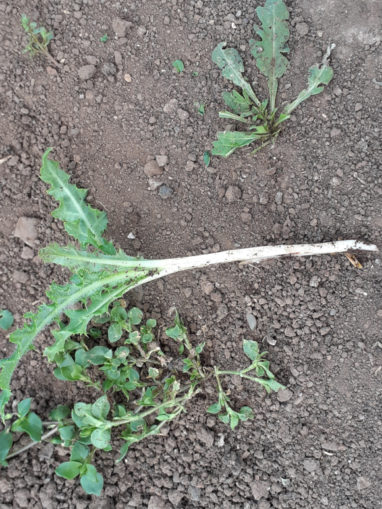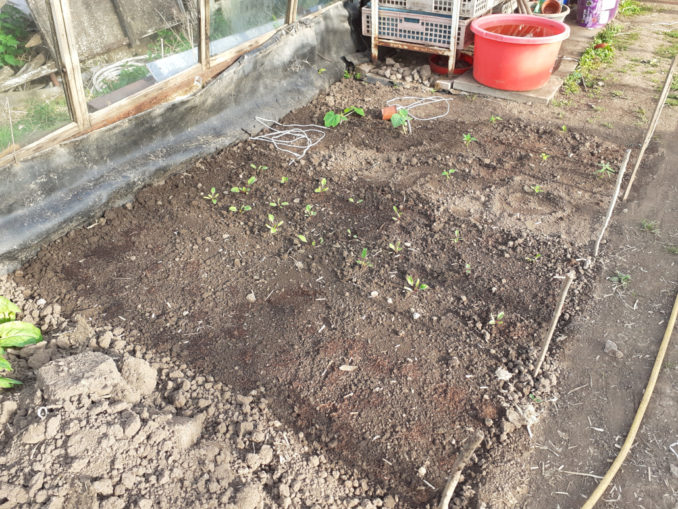
© Colin Cross, Going Postal 2020
Hello Postaliers, welcome to the latest progress report from the greenhouse at the end of the world, where summer has arrived early (as it often does) and work is limited, even with vents fully open and doors wide, to two or three hours in the morning. I use the word “work” in its loosest possible term. I’ve been a bit remiss in not recounting this tale. The broccoli which I’d hoped to still be eating now and for several weeks hence took one look at the weather and bolted (bolted is a technical term, it didn’t run away, it sprouted away, rendering it inedible). It left me with a bit of a dilemma, I hadn’t planted any brassica so far this year but I did have some Cavalo Nero seed which was nearly out of date. This posed yet another problem; Cabbage White butterflies and their offspring love brassica of any type. The challenge was, on the face of it, a simple one. How would I protect a small crop of cabbage, assuming germination, from this most annoying of pests?

© Colin Cross, Going Postal 2020
The answer was as simple as the question, construct a frame from canes and string, hang nylon mesh from it and weight the mesh at ground level with stones. I had the canes, I had the mesh, which I usually employ keeping blackbirds off the strawberries and, as previously revealed, there’s no shortage of stones to hand. In Cumbria this type of structure is often referred to as a “Yawk Up”, pronounced York up. To put it into context, someone might say; “How can we stop those sheep from getting over this wall” and someone else might reply; “I’ll yawk something up”. Ergo, a yawk up. I should add here that I do employ a second line of defence in this ongoing war against the insect world. There’s nothing quite so satisfying as knocking a cabbage white out of the sky when in mid flight with a decent stick. Addendum, a mouse got under the mesh and stole the smallest plant of four. On the plus side, no caterpillars.

© Colin Cross, Going Postal 2020
As tomato growth becomes more vigorous shoots begin to appear at the junction of leaf and stem, they’re call “side shoots”, for perfectly obvious reasons. At least once a week, as each plant progresses, I take the time to carefully “nip out” each one, always being careful to ensure that I don’t confuse the main growth at the top of the plant for one. It’s happened before and, although it isn’t ideal, neither is it the end of the world as a top “side shoot” can be trained (coerced may be a better description) into taking over the main growth’s job. Knowing me, there’ll be an example of that before the season is out.

© Colin Cross, Going Postal 2020
If there’s one single enemy for a rough old veg gardener then chickweed and thistle vie for the accolade. Both are deep rooted, they can survive seemingly in desert conditions and hoeing isn’t the answer to their presence. It’s a hands and knees job, two pronged fork, trowel and bucket at the ready and an understanding that, before the work is finished, hips, back, knees and ankles will be crying out for relief. It would possibly be easier to dig them up on first sight but, possibly because of the masochistic streak in me, I let them get semi established before removing as many of both of them as my body will allow in a single shift. Hard but satisfying work.

© Colin Cross, Going Postal 2020
Last week I started work on turning the last small uncultivated area of ground into a plot fit to grow something edible. After several “diggings” to break down the soil I finally got it planted up this week. Leeks are one of the few crops I’ve generally always grown directly from seed or, just occasionally, from plugs. I did try to apply the same method of propagating seedlings for transplanting but it wasn’t very successful. Divided roughly into three sections it now contains around 50 leeks, 24 beetroot of two varieties (transplanted as seedlings) a third yellow courgette, a mini cucumber, half a dozen pepper plants and one seedling, which may well be a weed, but I thought looked interesting enough to be given a chance. We’ll soon find out I suppose. The sticks are there to serve one purpose and that’s to ensure that when I drag the hose up and down the house it can’t damage young plants. The tomatoes are similarly protected. Forward “rough” thinking inspired by bitter experience!

© Colin Cross, Going Postal 2020
Lettuce and other salad leaves, including a first attempt at chicory, are starting to take recognisable shape. The ones that look furthest on were carefully transplanted from trays, the smaller ones are being grown from seed. Transplanting lettuce needs to be undertaken with care but it does remove the need for thinning out and wasting viable plants. I don’t much like waste.

© Colin Cross, Going Postal 2020
Growth is moving apace throughout the house, the vine is looking particularly impressive and bunches of tiny green grapes are forming. You might laugh, but it wasn’t until a couple of years ago that I realised my vine leaves are just the same as those used for culinary purposes. They are edible when young, straight from the tree and have a citrus flavour but they do leave you with a very dry mouth. I intend to find a recipe and stuff a few, if I get round to it I’ll let you know whether it works or not.

© Colin Cross, Going Postal 2020
All in all I’m very pleased with what’s been achieved so far, the tomatoes are now almost to the stage of not needing to be covered over night, due in no small part to the weather, although there are indications that we may be heading for a bit of a cold spell, I blame all that Global Warming, I’m sure we didn’t have it when I started with this project. A couple of potatoes haven’t germinated, as you can see from the gaps in the stitches, but I had four potatoes in the veg box that had put out shoots. I’d normally just trim the shoots off and cook the spuds, but in the spirit of “waste not, want not” I dug over the narrow section behind the onion patch, to the left of the picture and planted them there, alongside the third courgette plant. A lot of courgettes, one might think, but I use them to thicken soup and in vegetable stews. I also hope to swap them with the veg box people for things that I don’t grow.
Happy Rough Gardening
© Colin Cross 2020
The Goodnight Vienna Audio file
Audio Player



